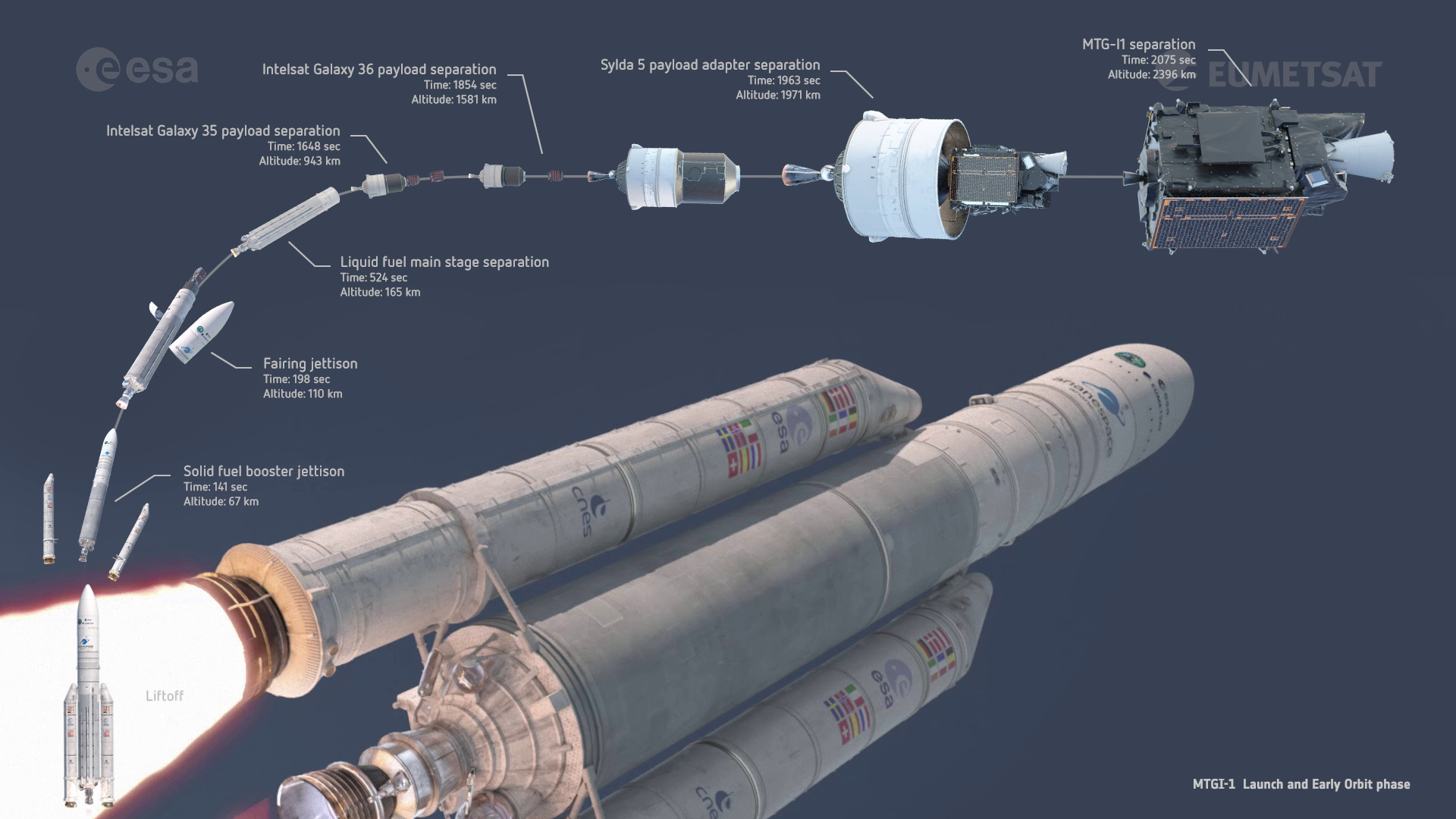9.11.2022
N° 57–2022: Media advisory: Launch of the first Meteosat Third Generation satellite MTG-I1

Media representatives are invited to witness the launch of the first Meteosat Third Generation satellite from Europe’s Spaceport in French Guiana. The launch is currently planned for 14 December at 17:30 in French Guiana (21:30 CET).
Meteosat Third Generation Imager-1 (MTG-I1) is the first of a new generation of geostationary satellites providing imagery for the early detection and prediction of fast-developing severe storms, weather forecasting and climate monitoring. Once in orbit, this cutting-edge satellite promises to further bolster Europe's leadership in weather forecasting.
Building on the long-standing partnership between ESA and Eumetsat, Meteosat Third Generation will guarantee the continuity of and provide improved, critical data for weather forecasting from geostationary orbit for the next two decades. The MTG system, one of the most complex and innovative meteorological satellite systems ever built, is based on a series of two types of satellite: four MTG-Imagers and two MTG-Sounders. In a first for Europe, MTG-I1 will also carry a novel Lightning Imager. The first satellite, MTG-I1, is planned for launch on an Ariane 5 rocket on 14 December 2022.
Journalists are invited to the following media activities.
Europe’s Spaceport draft programme
Tuesday 13 December - Thursday 15 December
At Europe’s Spaceport, journalists may view the launch from the media centre at the Jupiter control complex on 14 December, where there will be interview opportunities with representatives of ESA, Eumetsat and Arianespace.
Journalists may also have the opportunity to visit spaceport facilities for Ariane 5 and Ariane 6; details to be confirmed.
ESTEC launch event draft programme
Wednesday, 14 December
- MTG-I1 launch
The programme and media registration will be detailed closer to the date and can be modified at short notice because of operational constraints. A variety of high-level experts and spokespersons are available for interviews.
Online pre-launch press briefing
Monday, 5 December 2022 TBC
A detailed programme and media registration will be available closer to the date. A variety of high-level experts and spokespersons are available for interviews.
Quelle: ESA
----
Update: 30.11.2022
.
Locked and loaded

With liftoff now scheduled for 13 December, Europe’s first Meteosat Third Generation Imager (MTG-I1) satellite has been fuelled – a critical and extremely hazardous milestone on the road to launch. Once in geostationary orbit 36,000 km above the equator, this all-new weather satellite will provide state-of-the art observations of Earth’s atmosphere and realtime monitoring of lightning events, taking weather forecasting to the next level.
MTG-I1 has been at Europe’s Spaceport in French Guiana since mid-October being readied for liftoff. Over these last weeks, the satellite’s functionality has been checked out for the last time on terra firma, and all the ‘deployables’, namely the solar array, the Ka-band antenna and the Data Collection Service and Geostationary Search and Rescue instrument antennas finally locked ‘and loaded’ for launch.
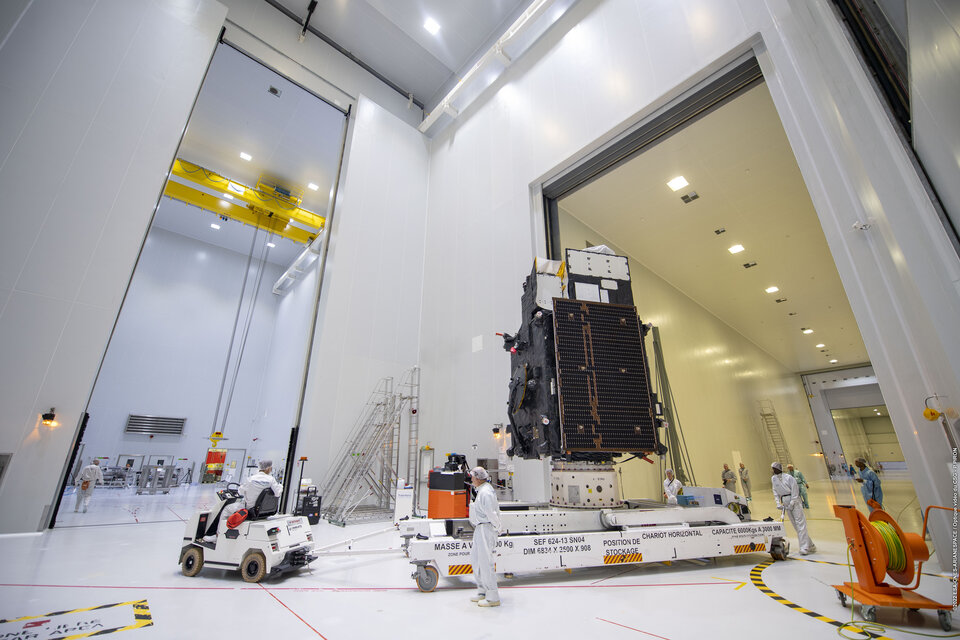
Having confirmed the satellite is ‘good to go’, the next step was to load the two tonnes of highly volatile fuel into the central tanks of the satellite that will power it to its final geostationary orbit and allow for 15 years of operational orbit maintenance.
This is an extremely delicate and potentially dangerous phase, with the highly toxic hydrazine and oxidiser being transferred from transport drums into the satellite.
To do this, MTG-I1 was moved to the S5B Hazardous Processing Facility, which has all the necessary detection and decontamination systems needed during this delicate process.
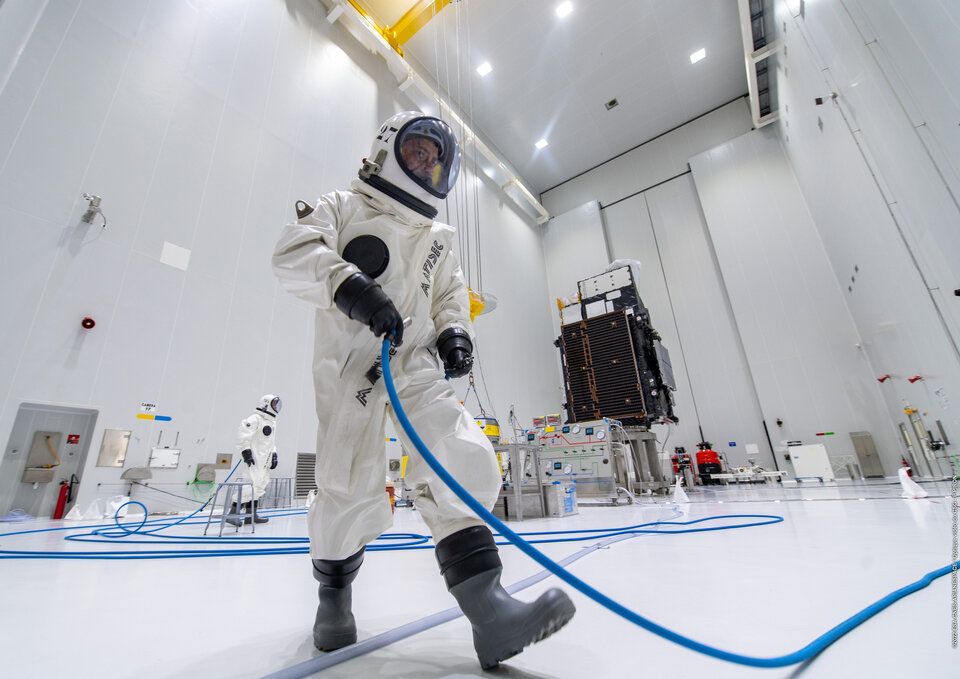
As can be seen from the photographs, the fuelling team is suitably attired in their ‘scape suits’ so that they are completely protected should any unexpected leak occur.
ESA’s launch campaign manager, James Champion, said, “Everything went smoothly, and all the teams here are very happy that we’ve passed this significant milestone in the launch campaign. Well done to the fuelling team from Thales Alenia Space in France who carried out this delicate operation without a hitch.”
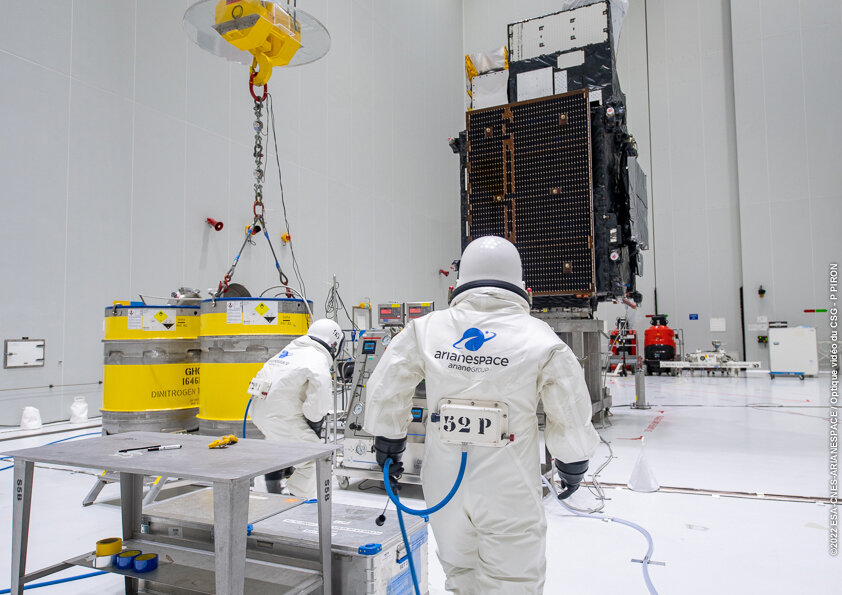
The next step for the fuelled satellite, which now weighs almost 3.8 tonnes, is to mount it onto the launch adapter.
This is the first part of the ‘combined operations’ phase with Arianespace where the satellite is assembled carefully into the upper composite of the Ariane 5 rocket. This step also involves the co-passengers, the Galaxy 35 and 36 telecommunication satellites, which occupy the upper position in the launcher fairing.
On 13 December, MTG-I1 will finally take to the skies on an Ariane 5 rocket. This date has actually been advanced by one day owing to a delay in the preceding Vega-C launch, which will now take place after MTG-I1.
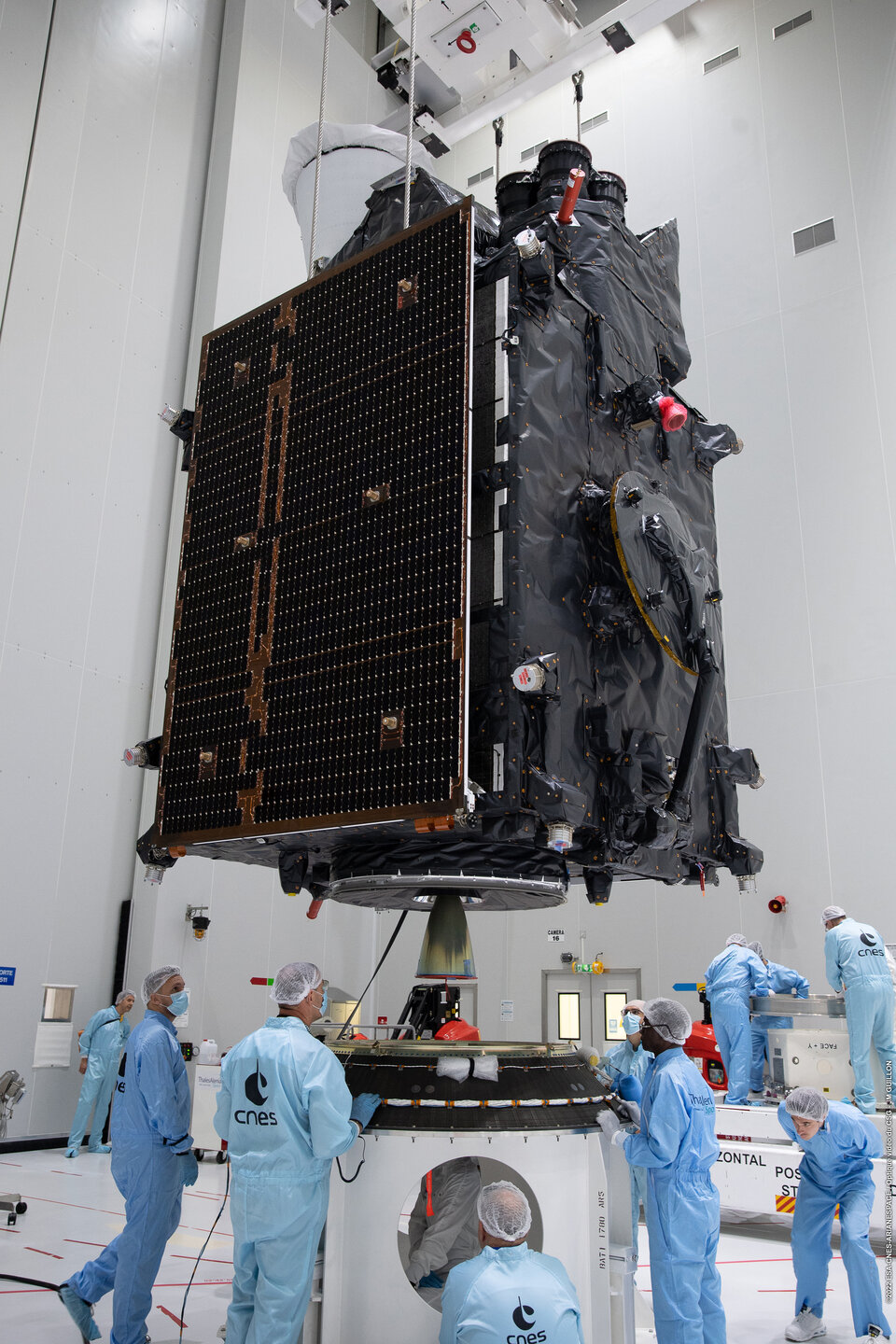
MTG-I1 is the first of six satellites that form the full MTG system, which will provide critical data for weather forecasting over the next 20 years. In full operations, the mission will comprise two MTG-I satellites and one MTG Sounding (MTG-S) satellites working in tandem.
The MTG-I satellites carry two completely new instruments, a Flexible Combined Imager and Europe’s first Lightning Imager, to deliver high-quality data for better weather forecasting.
The Flexible Combined Imager has more spectral channels and is capable of imaging in higher resolution compared to current Meteosat Second Generation’s Spinning Enhanced Visible and Infrared instrument.
The Lightning Imager offers a completely new capability for European meteorological satellites. It will continuously monitor more than 80% of the Earth disc for lightning discharges, taking place either between clouds or between clouds and the ground.
The MTG-I satellites also carry two smaller payloads for data collection from remote science beacons and for search and rescue by detecting emergency beacons.
These all-new instruments will allow severe storms to be detected in their early stages and will therefore be key for issuing timely warnings.

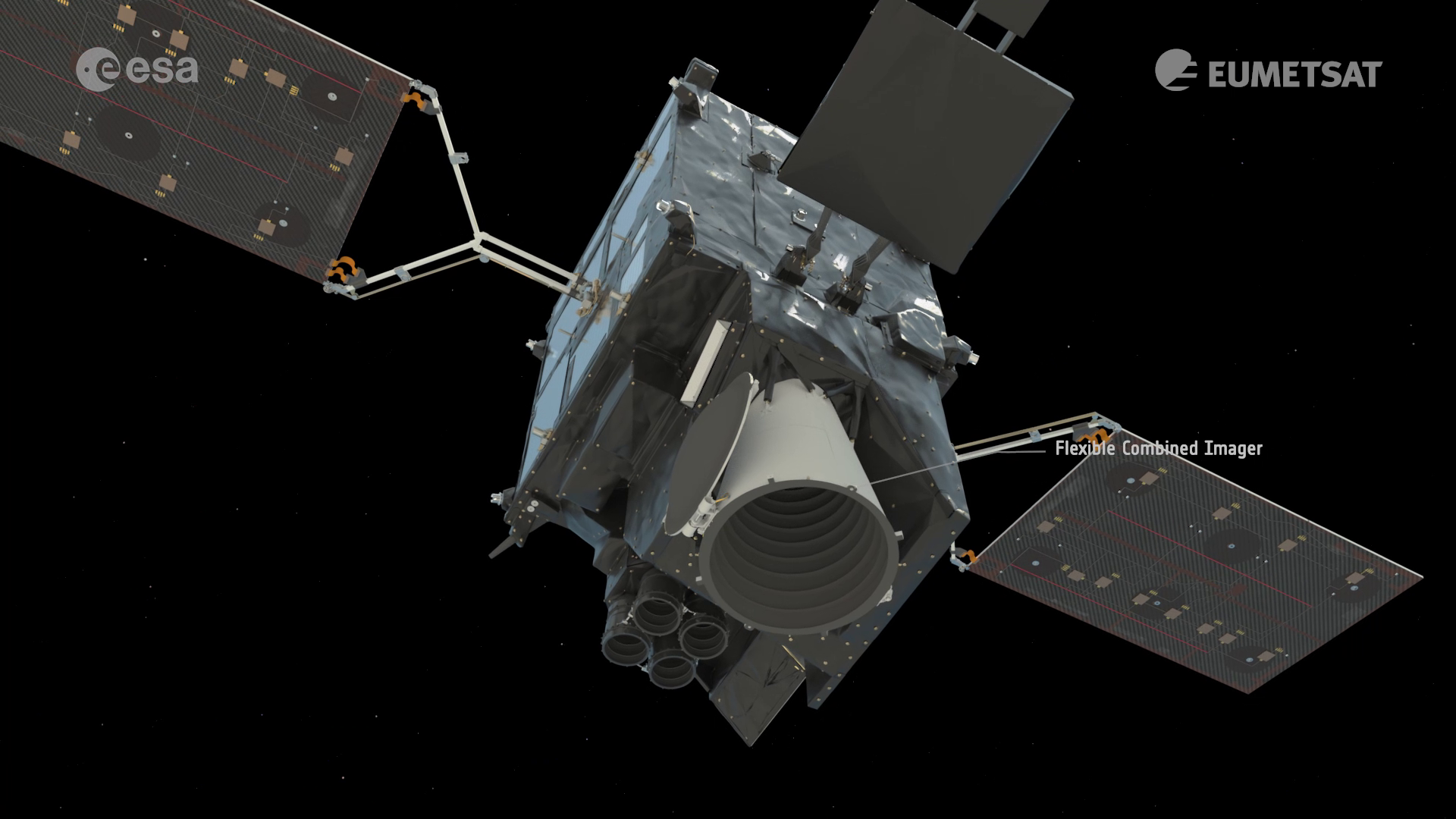
Access the video
The MTG mission is a cooperation between Eumetsat and ESA. ESA is responsible developing and procuring the six MTG satellites. Eumetsat defines the system requirements, develops the ground systems, procures the launch services, operates the satellites, and makes the data available to users.
Quelle: ESA
----
Update: 9.12.2022
.
MTG-I1 never to be seen again

As preparations to launch Europe’s first Meteosat Third Generation Imager satellite continue, the team at Europe’s Spaceport in Kourou, French Guiana, has bid farewell to their precious satellite as it was sealed from view within the Ariane 5 rocket’s fairing. This all-new weather satellite is set to take to the skies on 13 December.
Since its arrival at the spaceport in mid-October, MTG-I1 has been undergoing all that it takes to get it ready for liftoff. This includes a huge number of careful checks to ensure all its components are in good working order, the hazardous task of loading the satellite with two tonnes of highly volatile fuel and hoisting it on to the top part of the rocket.
In parallel the co-passenger, Intelsat Galaxy 35 and 36 were being mounted onto the Sylda structure and the fairing mounted, encapsulating the two satellites. This whole assembly was then hoisted almost 80 metres into the air and lowered very carefully over the MTG-I1 satellite to complete the launcher integration.
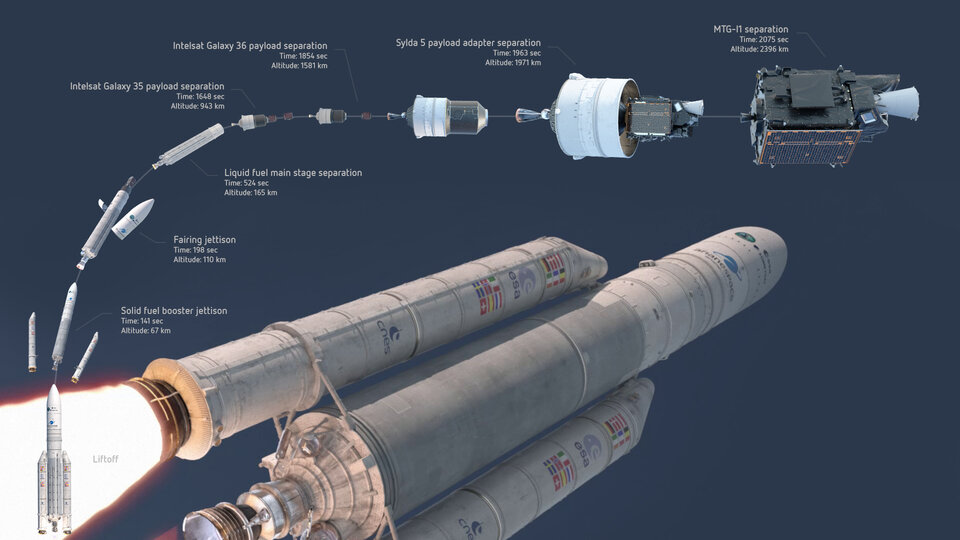
The fairing, which protects the payload satellites during the first stages of the launch, will be jettisoned a little over three minutes after liftoff when the rocket is about 110 km above the surface of Earth when the effects of the atmosphere are negligible.
At around 30 minutes after launch, the Galaxy satellites will be released to start their journey to geostationary orbit. Around five minutes after this the Sylda will be jettisoned, exposing MTG-I1. Finally, the clamp band holding the satellite will be released and MTG-I1 set free to fulfil its crucial mission.
ESA’s Meteosat Programme Manager, Paul Blythe, said, “It was a very emotional moment. We’ve spent more than 12 years developing and building the satellite so saying farewell is a significant milestone as it will never been ‘seen’ again by human eyes. Of course, our real good-byes will come next week when we see the rocket lift off.
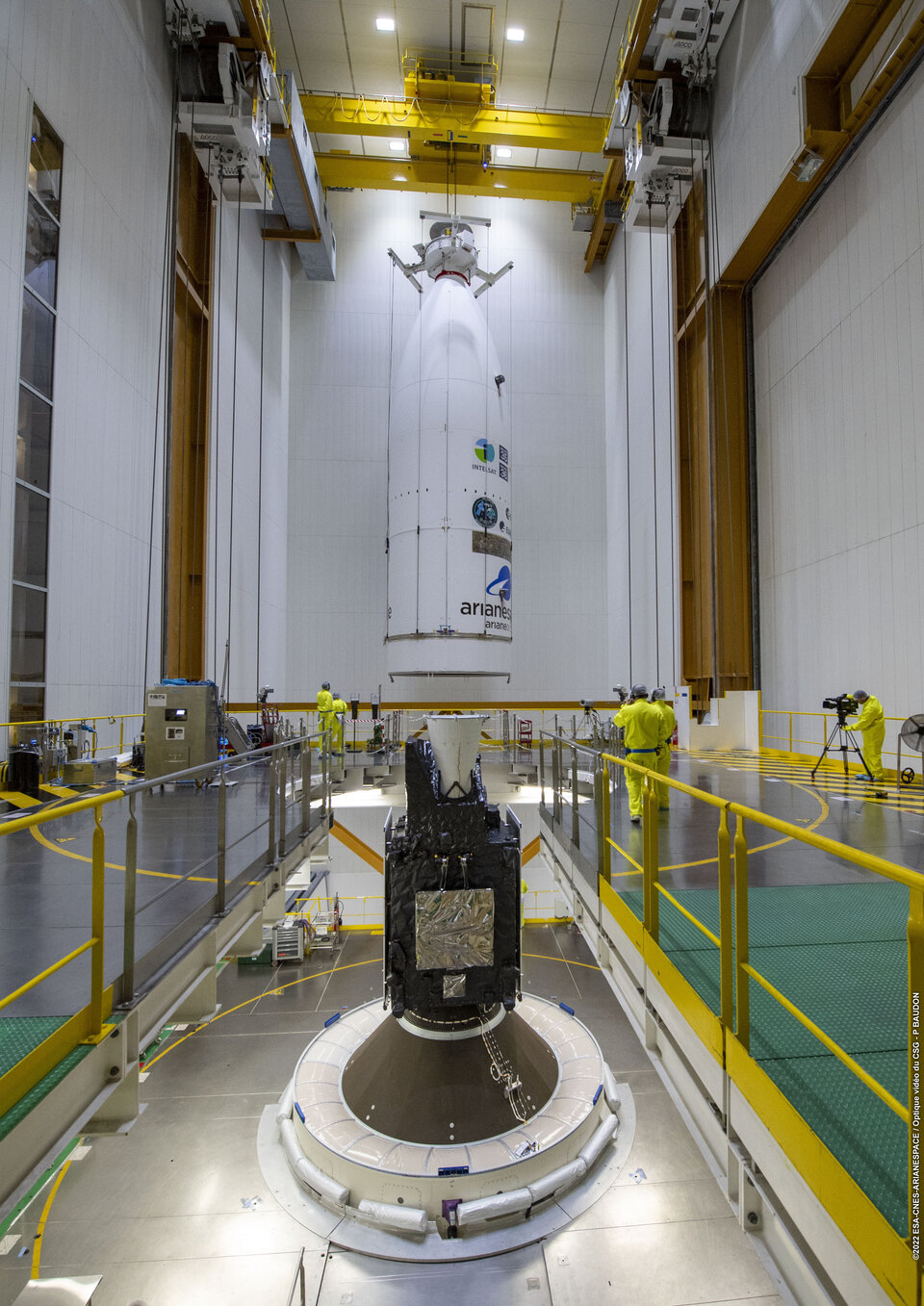
“The launch campaign has gone really well and that’s thanks to the close cooperation between the various teams all working hard to get the job done.
“Now that MTG-I1 is safely tucked up in the fairing, the next step is the launch dress rehearsal where we will practise the countdown, including the actual switch-on sequence of the satellite which takes around three hours. Then the launch readiness review will be held with Arianespace on Saturday, which should clear us for launch.
“The rollout of the Ariane 5 rocket to the launch pad, with our precious cargo, will take place on Monday, the day before the launch.”
MTG-I1 is the first of six satellites that form the full MTG system, which will provide critical data for weather forecasting over the next 20 years. In full operations, the mission will comprise two MTG-I satellites and one MTG Sounding (MTG-S) satellites working in tandem.
The MTG-I satellites carry two completely new instruments, a Flexible Combined Imager and Europe’s first Lightning Imager, to deliver high-quality data for better weather forecasting.

The Flexible Combined Imager has more spectral channels and is capable of imaging in higher resolution compared to current Meteosat Second Generation’s Spinning Enhanced Visible and Infrared instrument.
The Lightning Imager offers a completely new capability for European meteorological satellites. It will continuously monitor more than 80% of the Earth disc for lightning discharges, taking place either between clouds or between clouds and the ground.
These all-new instruments will allow severe storms to be detected in their early stages and will therefore be key for issuing timely warnings.
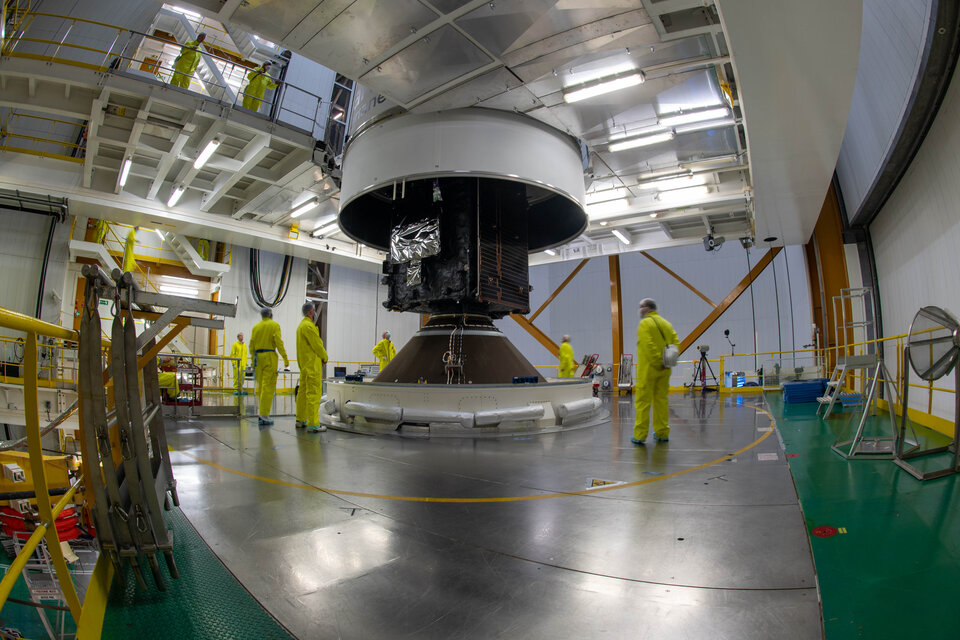
The MTG-I satellites also carry two smaller payloads for data collection from remote science beacons and for search and rescue by detecting emergency beacons.
The MTG mission is a cooperation between Eumetsat and ESA. ESA is responsible developing and procuring the six MTG satellites. Eumetsat defines the system requirements, develops the ground systems, procures the launch services, operates the satellites, and makes the data available to users.
Quelle: ESA
----
Update: 13.12.2022
.
Watch live launch of Meteosat Third Generation Imager-1

On 13 December, the first of a new generation of satellites designed to revolutionise weather forecasting in Europe will take to the skies. ESA and the European Organisation for the Exploitation of Meteorological Satellites (Eumetsat) invite you to follow the live coverage for the launch of the first Meteosat Third Generation satellite starting from 19:40 CET on ESA Web TV.
What is MTG?
The Meteosat Third Generation (MTG) system will help meteorologists meet one of their main challenges – the rapid detection and forecasting of severe weather events – so that timely warnings can be given to citizens, civil authorities and first responders.
Data from Meteosat Third Generation-Imager 1, the first satellite of the new generation, will have a wide range of uses, from enabling aircraft to avoid storms and for earlier alerts of flooding, through to more precise monitoring of fires and fog. It will help to protect lives, property and infrastructure and bring economic benefits to Europe and Africa.
The MTG-Imager will produce images of Europe and Africa every 10 minutes from the Flexible Combined Imager’s 16 spectral channels. The Lightning Imager will continuously map lightning flashes between clouds and from clouds to the ground. Higher resolution imagery will be available more quickly, in a significant advance for forecasting of rapidly developing severe weather events.
When is it launching?
The Meteosat Third Generation-Imager 1 is scheduled for launch on an Ariane 5 rocket from Europe’s Spaceport in French Guiana on 13 December 2022 at 21:30 CET (17:30 local time in Kourou).
Through live and recorded interviews and testimonials of MTG’s team members, partners, experts and users, the coverage will look back at the immense work and dedication of all teams involved in building this satellite system; allow you to witness the lift off and launch sequence up to separation via live connection with Europe’s Spaceport; and, finally, look forward at the highly anticipated applications and benefits of this new satellite system.
Watch the launch live on ESA Web TV and be part of the social media conversation using the hashtag: #MTGI1.
Programme:
19:40–21:00 CET
Meteosat Third Generation: Next-generation weather and climate monitoring; pre-launch talk show moderated by Kelsea Brennan-Wessels and Chiara Moenter, ESA; live from ESA’s European Space Research and Technology Centre (ESTEC)
21:00–22:15 CET
Live launch show from Europe’s Spaceport (retransmission Arianespace)
22:15–22:45 CET
Programme break
22:45–23:00 CET
Solar array deployment live announcement

